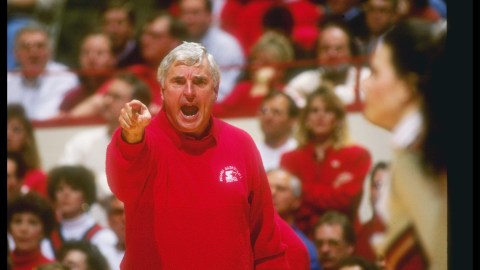Study: Teams often win after leaders give negative speeches

Gary Mook / Stringer
- A recent study analyzed 304 halftime speeches from 23 high school and college basketball teams.
- The results showed that teams generally played better in the second half of games after coaches delivered negative halftime speeches.
- However, teams tended to play worse after coaches delivered speeches that were too negative.
It’s halftime at a basketball game. You walk into one of the locker rooms and listen to the coach address the players. It’s pretty unpleasant. The coach is upset, expressing anger and frustration, and telling players that they’re not trying hard enough, that they’re underperforming.
Is this negative coaching strategy likely to lead to a better second half?
A new paper published in the Journal of Applied Psychology suggests the answer is yes. The researchers recorded 304 halftime speeches from 23 high school and college basketball teams and found that teams were significantly more likely to have a better second half when the coach delivered a generally negative halftime speech.
“That was even true if the team was already ahead at halftime,” lead study author Barry Staw told UC Berkeley’s Haas School of Business’ Newsroom. “Rather than saying, ‘You’re doing great, keep it up,’ it’s better to say, ‘I don’t care if you’re up by 10 points, you can play better than this.'”
To judge the halftime speeches, the researchers trained coders to listen to each recording and rate the extent to which the coaches displayed negative emotions (anger, fear, disgust) and positive ones (pleased, inspired, excited, relaxed). Interestingly, the results showed that teams generally scored more after negative halftime speeches, but not after speeches that were too negative.
“We’re talking Bobby Knight–level, when you’re throwing chairs,” Staw said, referencing the famously explosive former coach of the Indiana Hoosiers.
In a follow-up study, the researchers asked participants to listen to recordings of pep speeches and rate how motivated they felt at the end of each one. Similar to the first study, the results showed that participants generally felt more motivated after negative speeches. Why? The researchers suggest that players may redirect their attention and approach after hearing negative speeches. Also, they noted some workplace research showing that people tend to try harder — at least in the short term — when leaders display negative emotions.
Of course, positivity is also an essential quality in any team, and there’s plenty of research showing that organizations benefit when leaders display “positive affects” and foster a generally positive workplace. But Staw pointed out that negativity — when used correctly — can have its place.
Jordan Peterson’s guide to leadership
“We sometimes strip content from emotion, treating it as simply positive or negative expression, but emotion often has a message carried along with it that causes people to listen and pay attention, as leaders try to correct or redirect behavior,” Staw said.
Still, the recent study only found an association between negative speeches and better second-half performance; it didn’t establish causality. What’s more, basketball games are different than the modern 9-to-5 workplace. But for short-term boosts of motivation, the researchers suggest a stern halftime talking-to might be the right call.
“Our results do not give leaders a license to be a jerk,” Staw said. “But when you have a very important project or a merger that needs to get done over the weekend, negative emotions can be a very useful arrow to have in your quiver to drive greater performance.”





